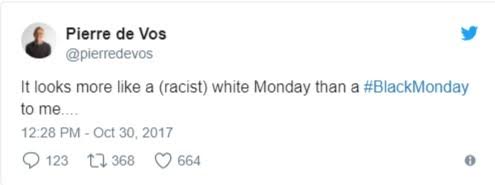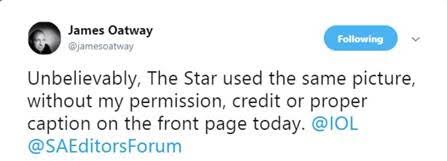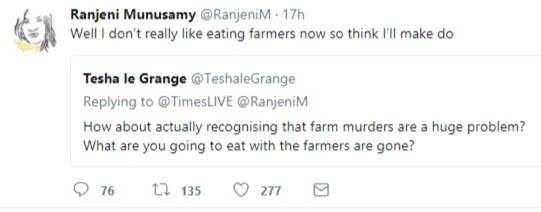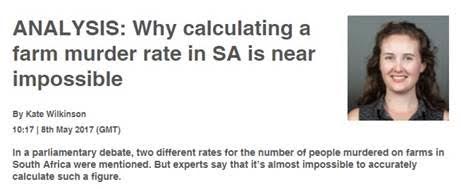Black Monday and the Burning Issue of Fake News
After the brutal murder of Western Cape farmer Joubert Conradie in Klapmuts, video footage of a grief-stricken plea from his friend Chris Loubser went viral. A visibly devastated Loubser asked whether something could please be done to draw attention to the scourge of farm attacks and murders plaguing the country.
His appeal would spark remarkably peaceful protests by farming communities and supporters nationwide. But instead of condemning crime and violence, some Twitter activists, media professionals, and politicians instead chose to cry “racism” and “white supremacy” rather than murder.

CAPTION: Pierre de Vos is Claude Leon Foundation chair in constitutional governance at the University of Cape Town. His Twitter account is followed by 93.7K people.
Black Monday organisers, their supporters and organisations like AfriForum feel that farm murders require a prioritised approach because of the frequency and often sheer brutality of these attacks. They claim that farmers are 4.5 times more likely to be murdered than other citizens and, given the vital role that farmers play in ensuring food security and creating employment, their plight affects more than just themselves and their families.
Those not blinded by animus witnessed something extraordinary; what could have been a seminal moment even. But early in the day, several photographs depicting the old South African flag surfaced on social media. And while it is true that a handful of political outliers carried old memorabilia, it transpired that many of the images were not taken on the day of the protests, nor even for that matter in South Africa.
The Fabrication of Narrative in Review
It started with the chattering classes on Twitter. The fake news was then unquestioningly accepted by some journalists and editors who decided to further disseminate this disinformation. Sensing a fine opportunity, the narrative was then spread by our politicians, including by South Africa’s minister of police, Fikile Mbalula.
Take for instance the following two fake news photographs retweeted by Mbalula, who has 1.11 million followers. The image on the left depicting the burning of the new South African flag was taken in 2012 in Delmas. The image on the right was taken in London during the 2013 Red October protests.

Attorney and twitter activist Tumi Sole has 50 000 followers. He is an EFF member and tweets under the popular hashtag #CountryDuty. He has previously claimed this hashtag receives 8 million monthly impressions. On Black Monday, Sole shared the following pictures:

On the left we again see the 2013 image taken in London. On the right a group of men crouch before an Oklahoma sign displaying the Vierkleur and old South African flag. The first traceable posting of this photo was taken at 8:10am on Monday morning by a Facebook user based in Meyerton, South Africa. It then resurfaced on various platforms and sites across the internet. One Twitter user noticed that something did not quite add up, and posted a thread where he detailed the suspicious origins, and subsequent sharing of the photo (including to Tumi Sole) by an equally suspicious account.
Oklahoma is seven hours behind South Africa. Local sunrise time is currently at around 07:54 am. The image could not have been taken on Monday morning. At worst a group of men could have gathered in advance to send their support ahead of the marches. If that is indeed the case, perhaps we could take a moment to realise these gentleman have already left our shores.
The original poster has failed to respond to requests for more information and Tumi Sole has since deleted his post. He has not however issued a retraction to his legions of followers.
The posting of racially-charged content of questionable origin is not a first on Sole’s account. A tweet of Sole’s earlier this year called for the firing of a FNB employee – allegedly the owner of a racist, apartheid-nostalgic Twitter account. Timeslive reported that this was retweeted more than 1 400 times. It later transpired the user did not work for FNB and “her” identity has never been verified. The Huffington Post then chose to report on this particular matter – as news and under their politics section – under the following headline:

The Huffington Post’s Engagement Editor, Marc Davies, chose to repost many of the offending images – which patently appear to be the work of an internet troll – with only a short disclaimer right at the very bottom saying the user had been “contacted for comment via Twitter, but has not responded at the time of publishing”.
It appears some journalists imagine themselves activists, rather than reporters. They fail to see their large number of Twitter followers the result of their affiliation to the media outlets they represent. And while they may claim their postings do not reflect the views of their employers, they do enjoy the privilege of public trust – trust that has been placed in them as the purported purveyors of credible and accurate news.
Nickolaus Bauer is an eNCA reporter. His twitter account is followed by nearly 35 000 people. On Black Monday he shared the following images:

Neither of the images were taken on the day of the protests. The first was taken in 2010 in Ventersdorp by photojournalist James Oatway. The second of the burning flag is the same taken in Delmas in 2012.
When this was pointed out to Bauer, he admitted the images were not of the protests and acknowledged he had “severely erred” in sharing them. He however added that “the message remains the same” and instead posted other photographs.
However, by the following morning his fake news continued to be shared hundreds and hundreds of times; his retraction only a couple of dozen.
Bauer has since made a commendable apology. But while anyone can make a mistake, it is certain that stakes have been significantly raised under our current political climate.
The Burning Issue of Fake News
The sudden proliferation and concentrated sharing of fake visuals created the impression that Black Monday was a spontaneous outburst by a throng of clamouring racists, rather than a fed-up and fearful community with the constitutional right to protest.
Screenshots of these fake visuals made their way onto online news platforms such as – again – the Huffington Post, where most of the images lifted off social media were fake, duplicates, or not related to the protests.
They were also published by DispatchLive, The New Age, The Daily Vox, ANN7, and were broadcast on TV, for example in the background of this SABC insert, which showed no less than four fake images.
It is interesting to note that once certain media outlets realised that these were treacherous fake news times, their subsequent articles (such as here, here, here, here, here, here and here) instead used stock, unrelated, or historical photos of the flag to make the points they were seemingly determined to be making.
Government Response
Arts and Culture Minister Nathi Mthethwa then released a statement where he not only condemned the old flag, but also the burning of the new one, which simply did not occur.
Communications Minister Mmamoloko Kubayi-Ngubane told Jacaranda FM that government respected the freedom of expression and the right to protest, but that it should be done in a responsible way. “There are images of people burning our flag and people having old flags, including people hurling insults," she said.
And most concerning, Defence Minister Nosiviwe Mapisa-Nqakula told the SABC, “The burning of the flag is what incensed me more than anything else. My view is that here you have people who are inciting racial divisions. Here are a people who have no clue of what a war can do in a country.”
The South African Human Rights Commission’s Jonas Sibanyoni appeared on eTV’s sunrise show to discuss not the matter of farm murders in the main, but rather that of the old flag. It should be noted the SAHRC has previously deemed even the use of the term “farm murders” as “stereotypical and divisive”.
In addition, Sibanyoni also condemned the (non-existent) burning of the new South African flag during an eNCA debate. This debate was held between himself, AfriForum’s Ernst Roets, and The Star editor, Kevin Ritchie.
Ritchie said “I think that very saddening today was that there was a narrative that began that could’ve been nipped in the bud”. He said it could instead have been a “nation-building exercise”.
He claimed – speaking as not just as an editor, but as a South African – that “we’re getting into narratives that polarise when we could have had a narrative that joined everybody together.”
And yet the day after Black Monday, The Star, which Ritchie edits, splashed James Oatway’s photograph that was taken seven years ago (2010), on its front page:

Media Analysis and Commentary
Ritchie claims he is opposed to the stirring up of racial polarisation. He says he supports nation-building. But when he then also pens a column that spreads fictitious news about flag-burning, and then wields stereotypical and prejudiced language – mouth-breathing, knuckle-dragging, two-tone khaki, kak haircut, vellie – it is hard not to feel it is because he simply doesn’t like Afrikaners very much at all.
After the day’s Twitter hysteria, the news was ripe for commentary. Ranjeni Munusamy, associate editor at Times Media (Tiso Blackstar), called BlackMonday a “reboot of the white right” in South Africa. She said it was “under the pretext” of protesting farm murders that those who had “preserved the apartheid flag for 23 years‚ and taught their children to sing Die Stem as the proud anthem of white-only rule‚ have found each other.”
According to Munusamy, there is fertile ground for this “white nationalist revival”.
“Nothing fuels racism and white supremacy more than black failure,” she said. “Add to the cocktail the belief of false victimisation and voila (sic): #BlackMonday!”
Munusamy could not seem to square up the killing of a mere 50 (the incorrect figure she provided) farmers, when compared to the many thousands of people murdered annually in South Africa.
“The message of Black Monday was that white life does matter and should maintain its place of privilege even in death,” she said.
“White nationalism,” she said, “should never be allowed space to flourish in our already besieged nation”. Munusamy did not mention whether this same stern interdiction should apply to black nationalism.
The Bogeyman Boer
Munusamy never mentioned the murdered farmer Joubert Conradie by name. Munusamy never mentioned his death at all.
Murdered farmers are nameless and faceless and oftentimes hidden behind the spectre of an a priori guilty boer bogeyman. When odious incidents such as the coffin case occur, such acts become attributed to all farmers, rather than to the criminals who commit them. These crimes also make for splendid click-bait and opportunistic political fodder.
South Africa’s farmers, both white and black, are a small minority who produce our food. The white farmers, however, collectively bear the yoke of responsibility for colonialism and apartheid about their necks. They carry it because they look like those who historically committed such crimes and because there is the unresolved and manipulated question of land.
But because we live in volatile and politically ungenerous times, it is important to stress the following: it is not to say that racism does not exist. It is not to say that parading old flags is not abhorrent. It is not to say some farmworkers are not abused. And it is most certainly not to say that white farmers alone are the victims of crime in a country besieged by violence, nor even by any means on the farms themselves.
It is however not simply a matter of “white bodies” mattering more than “black bodies”. Farmers are facing an unpredictable climate, water scarcity, land use conflicts from mining, and the ever-accelerating clarion calls for expropriation, without compensation, of their land. Add to this the dire physical insecurity of their personhood and property and we find ourselves upon a tinderbox.
And contrary to what many would have us believe, their fate is inextricably linked to the stability of the country.


Current discourse sounds like comeuppance and even victim-blaming - something so virulently opposed when it comes to discussions on women and the crime of rape.
Perspective
So while it is never a good idea to compare apples with oranges, and especially not pink lady apples, sometimes comparisons do offer perspective in the yawning chasm of where there is none.
The very day after #BlackMonday, it was reported that three more farmers had been felled, one of whom was black. I wondered what media response would be to the murder of three journalists in a single day. It appears South Africa’s food producers are simply not afforded the same level of concern or even respect for their efforts.
At the end of last year, Reporters Without Borders were “saddened” to report that “at least 74 professional and non-professional journalists [had] been killed in connection with their work in 2016”. This figure is for journalists across the globe and includes those deliberately targeted, as well as those killed during the course of their work.
Compare this to the latest estimated annual number of farm murders in South Africa, which the South African Police (SAPS) have released for the 2016/2017 reporting year. SAPS’s statistics show that 74 farm murders (and 638 farm attacks) occurred during the reporting period. According to FF Plus, this indicates a massive increase of 27,5% and 22,9% for farm murders and farm attacks respectively.
Africa Check
These latest SAPS statistics appear to be accepted by Africa Check. With their taglines of “sorting fact from fiction” and “we hold public figures accountable,” Africa Check’s studies are often treated as gospel. References to their work and statistics have made the news both locally and abroad in outlets such as the BBC.
But while the organisation has clearly done significant desktop research, they most certainly have not provided any answers. Their conclusion is merely to say that “calculating a farm murder rate in SA is near impossible.”
Africa Check’s more recent critiques appear to stem from differing figures put forward at a parliamentary debate held in March 2017.

South Africa’s overall murder rate – for all citizens – is 34 per 100 000. At the debate, Freedom Front Plus gave a farm murder rate of 133 per 100 000. The ACDP put the figure at 97 per 100 000. In October this year, AfriForum released a report alleging a figure of 156 per 100 000.
SAPS’s statistics show that when 57 police officers were killed, 74 farm murders occurred during the same reporting period. So while facts are indeed vitally important, perhaps we could start admitting we have a serious problem.
Social media does not reflect the real world, but platforms like Twitter do provide a cosy, but concerning echo chamber. It is where many journalists and editors spend their days staying up to date with the news, gauging what they perceive to be public sentiment, and then driving the very trajectory of our national discourse.

